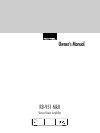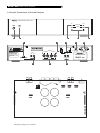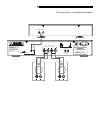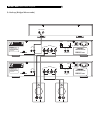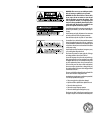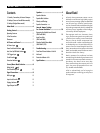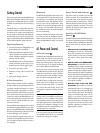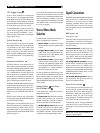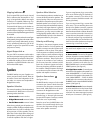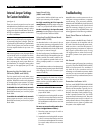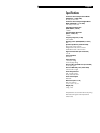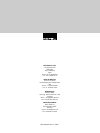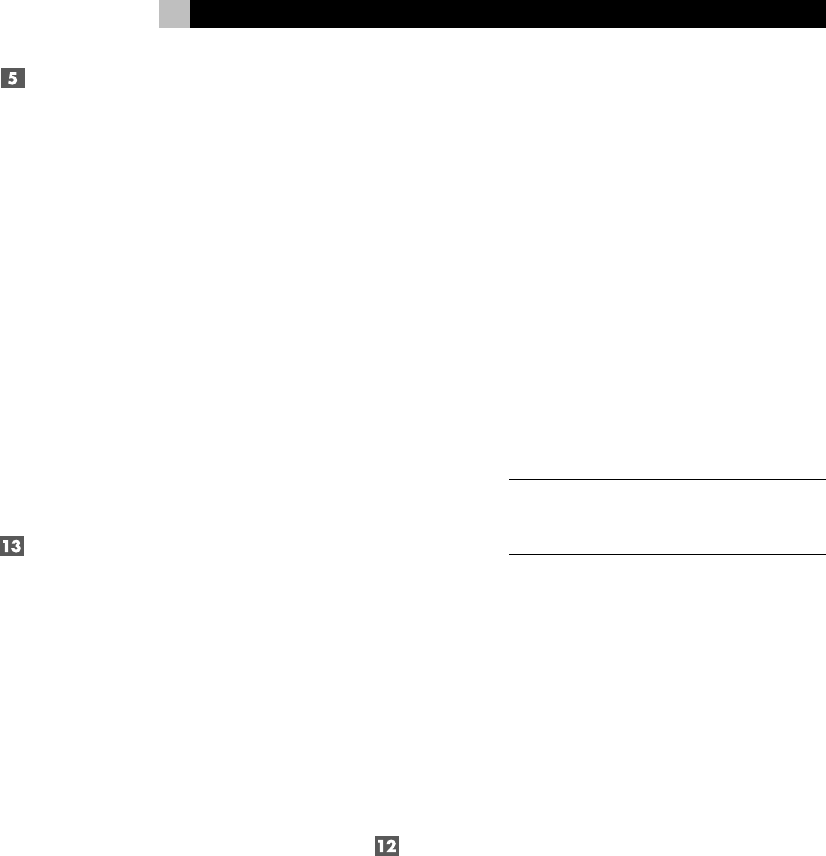
9
Clipping Indicators
Two front panel LEDs (one for each channel)
flash to indicate when the amplifier is “clip-
ping” or being asked to deliver more output
current than it is capable of delivering. Clip-
ping will cause distortion levels to increase.
Occasional brief clipping on the loudest mu-
sical passages is acceptable. However, sus-
tained or frequent clipping is one of the most
common causes of speaker damage and should
be avoided.
Should this occur, either reduce the overall gain
of the system by turning down the master volume
control on your preamp. Alternatively, you may
wish to permanently reduce the gain of the
amplifier using the front panel level controls
(see previous section).
Signal Output Link
This pair of RCA connections can be used to
pass the unprocessed input signals to another
audio component, for example to “daisy-chain”
an additional amplifier to drive a second set
of speakers. Any INPUT SIGNAL is also avail-
able at these LINK outputs.
Speakers
The RB-951MkII has two pair of speaker con-
nectors, one pair for each channel. These can
be used to connect two loudspeakers in Ste-
reo mode, or to connect one loudspeaker in
Bridged Mono mode.
Speaker Selection
The nominal impedance of the loudspeaker(s)
connected to the RB-951
MkII in the various
operating modes should be:
• Stereo mode: minimum 4 ohms
• Bridged Mono mode: minimum 8 ohms
• Parallel Mono mode: minimum 2 ohms
When driving multiple pairs of speakers con-
nected in parallel, the effective impedance the
amplifier sees is cut in half. For example, when
driving two pair of 8 ohm speakers, the am-
plifier sees a 4 ohm load. When driving mul-
tiple speakers in parallel, select speakers with
a nominal impedance of 8 ohms or higher.
Speaker Wire Selection
Use insulated two-conductor stranded wire to
connect the RB-951
MkII to the speakers. The
size and quality of the wire can have an au-
dible effect on the performance of the system.
Standard speaker wire will work, but can re-
sult in lower output or diminished bass response,
particularly over longer distances. In general,
heavier wire will improve the sound. For best
performance, you may want to consider spe-
cial high-quality speaker cables. Your autho-
rized Rotel dealer can help in the selection of
appropriate cables for your system.
Polarity and Phasing
The polarity – the positive/negative orienta-
tion of the connections – for every speaker and
amplifier connection must be consistent so all
the speakers will be in phase. If the polarity
of one connection is mistakenly reversed, bass
output will be very weak and stereo imaging
degraded. All wire is marked so you can iden-
tify the two conductors. There may be ribs or
a stripe on the insulation of one conductor.
The wire may have clear insulation with dif-
ferent color conductors (copper and silver).
There may be polarity indications printed on
the insulation. Identify the positive and nega-
tive conductors and be consistent with every
speaker and amplifier connection.
Speaker Connections
See Figures 2
& 3
The RB-951
MkII has one pair of color coded
connections per channel. Labels above the
connectors show the proper connections for
Stereo mode. Labels below show the proper
connections for Bridged Mono mode.
These speaker connectors accept bare wire,
connector lugs, or “banana” type connectors
(except in the European Community countries
where their use is not permitted).
Route the wires from the RB-951
MkII to the
speakers. Give yourself enough slack so you
can move the components enough to allow
access to the speaker connectors.
If you are using banana plugs, connect them
to the wires and then plug into the backs of
the speaker connectors. The collars of the
speaker connectors should be screwed in all
the way (clockwise).
If you are using terminal lugs, connect them
to the wires. If you are attaching bare wires
directly to the speaker connectors, separate
the wire conductors and strip back the insu-
lation from the end of each conductor. Be careful
not to cut into the wire strands. Unscrew (turn
counterclockwise) the speaker connector col-
lar. Place the connector lug around the shaft,
or insert the bundled wire into the hole in the
shaft. Turn the collars clockwise to clamp the
connector lug or wire firmly in place.
NOTE
: Be sure there are no loose wire strands
that could touch adjacent wires or connec-
tors.
In Stereo mode: Connect the left speaker
to the pair of speaker connectors labeled CH1.
Connect the right speaker to the speaker con-
nectors labeled CH2. Follow the labels printed
above the connectors and make sure the
BRIDGE MODE switch is set to the NORMAL
STEREO position. (See Figure 2)
In Bridged Mono mode: Connect the posi-
tive terminal of the speaker to the speaker con-
nector labeled BRIDGE +. Connect the nega-
tive terminal of the speaker to the speaker con-
nector labeled BRIDGE –. Follow the labels
printed below the connectors and make sure
the BRIDGE switch is set to the BRIDGE MONO
position. (See Figure 3)
In Parallel Mono mode: Connect the speak-
ers in the same fashion as in the Stereo mode.
You can use the connectors for either chan-
nel or both – the same output signal is present
at both pair of connectors. (See Figure 2)
English



